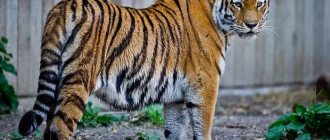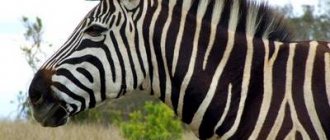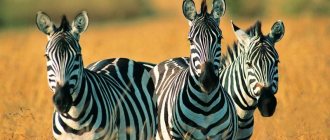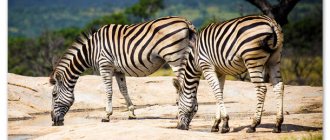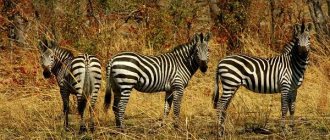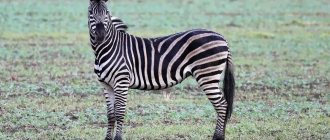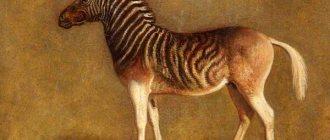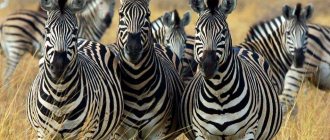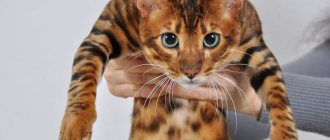Zebra: general characteristics
Zebras belong to the class of mammals, herbivores, are part of the order of equids, and together with horses, donkeys and kulans they represent the equine family.
Brief history of origin
Although zebras are closely related to domestic horses and donkeys, and in fact descend from a common ancestor, the formation of these species occurred along different paths. The ancient animal pliohippus, which became the ancestor of the horse family, originally lived on the American continent, and began to explore new territories 2.5 million years ago.
Zebras belong to an ancient family of animals, and are the closest relatives of horses.
During the mass migration, plyohypuss gradually spread throughout the northern hemisphere of the planet. Most of the animals moved further north, populating the Eurasian continent, and some individuals remained in Africa, laying the foundation for the line of modern zebras.
Description of appearance
Zebras are similar in body type to horses, but there are significant differences between them. African horses are smaller, their bodies are denser and squat, and, of course, their main feature is their original striped color. Each zebra has a unique pattern, and it is impossible to find two animals with the same pattern on their skin.
The pattern on the body of each zebra is unique and unrepeatable
Scientists have still not come to a consensus on what the main color of a zebra is: black or white? For a long time it was believed that these creatures were white with dark stripes. But in the course of repeated studies, experts made a striking conclusion that the skin of zebras still has a predominant pigment of black color, and the pattern on their body is formed by white stripes.
Wild African horses reach a height of no more than 1.5 m, and weight, depending on the variety, ranges from 250 to 430 kg. The zebra has a short, stiff mane that starts at the base of the head and extends along the back along the spine, in some subspecies it reaches the tail. The animals' limbs are strong and muscular, with hard, wide hooves that zebras use to fight off predators. By the way, the hooves are not the only weapons of these creatures; males also have fangs, so males are capable of biting very painfully.
Zebras have large, elongated ears, and there is a fluffy tassel on the tail, which gives them a resemblance to domestic donkeys.
How to distinguish a male from a female?
Zebra is a fairly large animal.
The length of her body is more than 2 meters, and her weight is 300-350 kilograms. The tail is usually not very long. It grows up to 50 centimeters. The height of this striped creature is approximately 1.4 - 1.5 meters. But males are usually somewhat larger and taller than females. So it is higher growth that is the main distinguishing feature of males. The physique of zebras is quite dense. Their mane is very stiff and short, resembling stubble. The neck of these striped horses is very muscular. Moreover, in males it is much thicker than in females.
How long do zebras live?
The lifespan of zebras varies between 25-30 years, but in the wild they rarely reach such an advanced age. But in zoos, African horses live up to 40 years, since in captivity they do not have to starve, and predators do not make attempts on their lives.
Elena
Ask a Question
Question to the expert
Why didn't man domesticate the zebra?
These animals were never domesticated, although attempts were made to domesticate them several times. But neither the local aboriginal tribes, nor the Roman conquerors, nor the European colonialists managed to make a domestic horse out of the zebra. Indeed, unlike donkeys and horses, striped creatures are very timid, have an obstinate disposition, and are generally not amenable to training. Living among predatory animals, zebras had to become cautious and distrustful, and suspicious of any living creature, including humans. Therefore, despite all the efforts of people, African horses remained wild and free.
Captivity
Most often, an animal in captivity is in a zoo and its maintenance is completely similar to caring for wild horses:
- kept in stalls protected from weather;
- They offer regular horse feed for food;
- control overeating.
Animals should not be given human food, especially bread, corn flakes, chips, or sugar cubes. Such nutrition provokes a number of diseases and shortens the life of an individual.
Zoo workers periodically trim the hooves, since in captivity an animal cannot fully grind them off on its own, which leads to severe suffering and pain.
They try to keep adult males separately so that they do not behave aggressively towards each other. Hybrids are used on the farm like ordinary horses or donkeys and are kept in the same way.
Not only representatives of the horse family are called zebra. These could be exotic fish and the popular snail, which received the prefix zebra to their names because of their unusual, bright color.
Habitat
The ancestors of modern zebras appeared in Africa about 2 million years ago, and successfully populated the entire Black Continent. But with the advent of man on the planet, who hunted herbivores, the habitat of these amazing creatures gradually decreased, and now their natural environment is limited to the southern and eastern parts of the continent.
Zebras were once found in every corner of Africa
Zebras are common in the following African countries:
- Namibia;
- SOUTH AFRICA;
- Sudan;
- Ethiopia;
- Kenya;
- Somalia;
- Angola;
- Uganda.
Zebras still live in the wild, but even in most of the above countries they live in nature reserves and national parks, and are protected at the state level. Local municipalities have created special units whose task is to protect animals from poachers and hunters from aboriginal tribes.
Population and species status
Not so long ago, zebras lived across vast areas of the African continent, and their numbers did not pose any threat to populations, regardless of variety. Nowadays, the total number of these representatives of the equine family has decreased significantly. As a rule, this is due to a number of many factors that negatively affect the life activity of this animal species. Hartmann's mountain zebra now numbers about 15 thousand individuals, which indicates a reduction of almost 8 times. The Cape mountain zebra is protected.
What do zebras eat?
The flora of the African savannahs is not rich and diverse, so zebras don’t have much to choose from. The diet of striped horses consists of grasses and plants, and is determined by their habitat, as well as the time of year.
Zebras eat exclusively plant foods
The zebra menu includes:
- Lush green grass;
- Leaves of bushes and trees, as well as tree bark;
- Buds and young shoots of bushes;
- Roots and tubers of plants;
- During the dry season, they feed on sun-scorched grass.
With such a meager, low-calorie diet, zebras have to feed 12-15 hours a day. And for the normal functioning of the body, they need a lot of water. Adults can drink up to 10 liters of liquid per day; water is especially important for pregnant and lactating females, who drink about 15 liters per day.
Zebras prefer to stick to pastures located near natural bodies of water. And when rivers and lakes dry up, animals use their hooves to dig holes in the dry soil, up to 1 m in diameter and up to 50 cm deep, which are filled with liquid from underground sources or rainwater.
Nutrition
Herbivores require a significant amount of food to saturate the body with the required number of calories. The food is succulent grass cover, plant rhizomes, leaves, buds on bushes, tree bark, and any young shoots. Animals are constantly engaged in obtaining food. During the dry season, herds head out in search of pastures.
Animals have a vital need for water and need it at least once a day. Water is especially important for lactating females. In search of sources for watering, herds travel considerable distances. If rivers dry up due to the heat, zebras look for underground channels - they dig real wells, up to half a meter deep, and wait for the water to drain.
The feeding habits of various mammal species depend on the region where they live. Thus, the diet of desert zebras is dominated by roughage food with a fibrous structure, bark, and foliage. Mountain individuals feast on the soft, lush grass covering the green slopes. Zebras do not refuse juicy fruits, buds, and tender shoots.
In addition to natural grazing, tamed individuals are fed with mineral supplements and vitamins, which increases physical endurance and affects longevity.
Lifestyle and character traits
Although zebras are closely related to domestic horses and donkeys, their lifestyle and habits are radically different from the lifestyle and disposition of their equid tribesmen domesticated by humans. After all, zebras had to adapt to survival on one of the harshest and most inhospitable continents, which left an imprint on the character of these animals.
African horses are not tied to one territory, and are constantly moving in search of new pastures, although they can stay for a long time in a certain place, rich in lush vegetation and natural water sources.
Social structure
Zebras lead a collective lifestyle, gathering in herds, which in turn form separate family units of large herds. There are from 10 to 15 individuals in one herd, and they consist of a mature male, 3-5 females and young foals. Groups form into herds, which sometimes number up to several hundred animals, but each herd keeps to itself.
Zebras live in small herds
Mating of zebras occurs exclusively between members of their family, and herds are often separated from the general group in order to join another herd. Actually, we can say that each herd lives its own life, feeds and goes to watering separately, and zebras gather into one huge herd only at night, during migrations or to fight off predators together.
There is a strict hierarchy within each herd. The leader of the zebra family is an adult, strong male, whose main responsibility is to ensure the protection of his personal “harem” and offspring from predatory animals. The second in status is considered the most mature and experienced mare. It is under her leadership that the herd goes to a watering hole or goes in search of new feeding places. When moving, zebras always adhere to the following order: the main female leads the procession, followed by other mares, closing the cubs in a tight ring, and the male of the herd brings up the rear.
Reproduction and care of offspring
The first estrus in female zebras occurs at 1.5 years of age, and males are ready to mate upon reaching 2 years of age. But these animals do not become fully sexually mature until they are 3 years old. And often, a striped mare brings her first offspring at the age of 4. Zebras retain their ability to reproduce until they are 16-18 years old.
Surprising fact: although all varieties of zebras are closely related and descend from a common ancestor, they do not mate with each other, even when their paths cross. If a savannah zebra becomes pregnant by a representative of a mountain species, she will have a miscarriage or a dead baby will be born.
Mating season for zebras
Zebras are able to reproduce throughout the year, but the mating period usually occurs during the rainy season, when arid savannas and African steppes are filled with life-giving moisture, and equids can feast on luscious grass to their heart's content.
The male courtes females only from his herd
Since in a herd of zebras there is only one adult male, who has sexual intercourse exclusively with his own striped wives, battles for a female among these animals are not a common event. But if a single alien male claims to be the head of the group, then real battles take place between the males. And when a young male manages to defeat a mature leader, he gets a valuable prize: a formed herd, a personal harem, and the opportunity to cover all his females.
Although zebras are loyal to their relatives, they have one cruel custom. If a foreign male kills or expels the leader of the family, he kills all newborn foals. Scientists believe that such an act of the new leader was dictated not by bloodthirstiness, but by the desire to infuse his genotype into the herd won in battle.
Duration of pregnancy and childbirth
Pregnancy in wild African horses lasts 12 months. After this period, only one cub is born; very rarely there are twins in a litter. During the maternity process, the male vigilantly guards his mate, making sure that no predator gets close to the newborn foal and the mother, weakened by childbirth.
A baby zebra is born weighing 30 kg, and within 15-20 minutes after birth he stands on his feet and takes his first steps. The new mother shields her baby from other zebras with her body so that he remembers her unique pattern. It is by the pattern on the female's skin, and not by the smell, that newborn foals unmistakably find their mother.
Zebras feed their young with milk, which is not white, like all mammals, but pink. The milk of African horses contains all the minerals and vitamins a young foal needs, and also fills its intestines with beneficial bacteria that help digest plant foods.
Caring for the young
Although young horses are able to feed on grass after the first week of life, females feed them milk for another 10-12 months. A zebra family takes care of its brood until the foals are 1.5 years old. Adults protect young offspring from predators, and in the event of an attack by the latter, they hide the babies inside the herd, and all adult members of the striped family bravely engage in battle with the enemy.
The striped baby follows its mother relentlessly
Upon reaching 1.5 years of age, males are expelled from the herd, and they have to lead a solitary existence until they acquire their own harem. And young females are allowed to remain in their native group, although some of them prefer to leave and look for a new family.
Question to the expert
Can zebras mate with domestic horses?
Yes, and not only with horses, but also with donkeys. A hybrid of a zebra and a horse is called a zebroid, it looks more like a horse, but has characteristic stripes. A cross between a zebra and a donkey is called a zebrull, they differ in that the stripes are present only on certain parts of the body. Such hybrids are very aggressive, but at the same time amenable to training, and they are used as pack or circus animals.
Zebra's enemies in the wild
Recommended by topic
Chinchilla Raccoons Toucan
The life of zebras certainly cannot be called peaceful and serene. Danger awaits them from all sides, so wild striped horses constantly have to be on the alert. After all, Africa is the original homeland of many representatives of the large cat family, for which zebra meat is a favorite delicacy. Next to the herds of odd-toed ungulates, packs of eternally hungry hyenas and hyena-like dogs prowl. And at watering holes, zebras often become prey for Nile crocodiles.
The main enemy of zebras is the king of animals himself - the African lion. Huge cats live in prides, which is their undeniable advantage when hunting these animals, since a zebra has almost no chance of escaping from a group of lions. Thanks to collective hunting and centuries of honed skills, lions can afford to attack adults. Often, predators sneak up on a herd under cover of darkness, surround it with a dense ring, after which a lightning attack occurs on the nearest zebra.
An encounter with lions almost always ends in the death of a zebra.
Unlike lions, cheetahs and leopards hunt alone, so they have to be content not with adult animals, but with young foals. A leopard stalks a herd of odd-toed ungulates near water bodies, marks a suitable object, then overtakes the victim in one jump, and quickly kills it by biting the carotid artery. The cheetah's method of hunting does not consist of ambush, but of pursuing prey, and not every zebra manages to escape from the fastest predator on the planet.
Hyenas and wild dogs also pose a threat to young zebras, and newborn foals are especially vulnerable to them. These spotted animals circle around the herd, trying to create panic among the wild horses and separate the young horses from the herd, on whom they attack with the whole pack. Old and sick zebras are dying from the teeth of hyenas, because they are too weak to resist the evil predators that surpass them not only in strength, but also in number.
Zebra cubs are the main target of bloodthirsty hyenas
When going to a watering hole or during the migration season, when herbivores need to cross the river, zebras risk ending up in the jaws of a crocodile. A huge reptile grabs the striped horse by the neck and drags it into the river. Moreover, the zebra still has a chance to fight off one crocodile, but if its combed relatives rush to the reptile’s aid, the fate of the unfortunate victim is sealed.
And yet, not a single four-legged predator over the millennia of its existence has caused such damage to the zebra population as humans have. For centuries, people have mercilessly destroyed these creatures for the sake of their striped skin, and due to human fault, some species of zebras have already disappeared from the face of the earth, and the remaining species are in danger of extinction.
Zebras are not only unique, but one of the most interesting representatives of the animal world in Africa. Unfortunately, many people do not realize that these horses are beautiful in the savanna landscape, and not as a trophy pelt on the wall. And whether these animals will be preserved in the wild, or whether only museum stuffed animals will remain of them, depends on the person and his awareness of how mysterious and unique wild nature is.
Why does a zebra have striped skin?
The peculiar color of the skin helps protect the animal from insects that do not perceive the striped object as something edible.
The main pests for the inhabitants of the savannah are horseflies and Tsetse flies, which are carriers of various infections. As a rule, they do not bother zebras, thanks to their protective stripes. We also recommend reading:
The largest dog breeds What is domestication in animal husbandry Why you should get a cat: reasons voiced by scientists Euthanasia of animals
Also, striped skin promotes good thermoregulation of the body. Black stripes heat up more, and white stripes heat up less. This promotes good microcirculation of air flows near the zebra, which allows it to feel quite comfortable even under the scorching sun.
The peculiar color allows the animals to escape from predators, masterfully disorienting them. When moving, the zebra's outline blurs, and it literally merges with the trembling hot air. Striped horses can reach speeds of up to 80 kilometers per hour. During the chase, they prefer to run in zigzags, so it is almost impossible to see them.
In the event of a direct attack, zebras tend to beat and bite their opponent to death. They have very strong legs with very powerful weapons - hooves. These wild horses always stay in small groups. Their acute sense of smell helps them notice the enemy in time, since their eyesight is rather weak. They inform other members of the group about a possible attack by emitting a loud barking cry.
